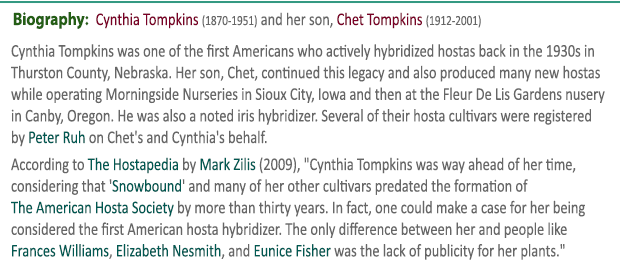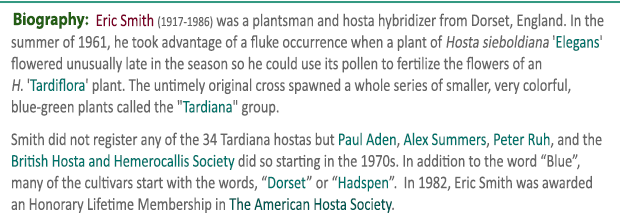|
 Originated by
Chet Tompkins of Oregon and registered by
Paul Aden of New York in 1978, this
medium to large size hosta has chartreuse leaves with multicolored streaks. It
has funnel shaped, lavender flowers on
22 inch scapes. Originated by
Chet Tompkins of Oregon and registered by
Paul Aden of New York in 1978, this
medium to large size hosta has chartreuse leaves with multicolored streaks. It
has funnel shaped, lavender flowers on
22 inch scapes.
This cultivar is
considered unstable and may revert into the plain, light green plant
shown above or into a creamy/yellow medially (center) variegated
cultivar
H. 'Shade Fanfare'.

According to
The Hostapedia by Mark Zilis (2009), "...origin: (X-ray bombardment of a gold
seedling...attracted the attention of just about
every hosta collector in the early 1980s...Thousands
of 'Flamboyant' plants were propagated and sold, but
after being grown for a while, it was realized that
they were something different...has faded in
importance as a garden plant, but continues to be
used by a few hybridizers."

Warren I. Pollock in
The
Hosta Journal (1992 Vol. 23 No. 2) states that, "H.
'Flamboyant' with its streaked variegation was a "must have" hosta at that time.
The problem was that many who purchased it found that it started to turn - and
in many cases had completely turned - into 'Shade Fanfare' a year or two later."
 Bob Solberg
wrote in
The
Hosta Journal (1994 Vol. 25 No. 2) that "William
and Eleanor Lachman crossed the better blues of
Eric Smith with their own line of variegated
'Beatrice' and 'Flamboyant'
hybrids to yield a large group of blue hostas with
cream to white variegation - unlike any previously
introduced: 'Cherub'...and
'Crusader'...both
registered in 1989 are two examples of this
breakthrough. Some may also consider the Lachman's
earlier introductions of 'Carnival'
and 'El Capitan'
as breakthroughs for their substance and bright gold
edges, although 'Galaxy',
their streaked sibling, is of more value to
hybridizers. All have 'Beatrice'
and some 'Tokudama'
in their pedigrees." Bob Solberg
wrote in
The
Hosta Journal (1994 Vol. 25 No. 2) that "William
and Eleanor Lachman crossed the better blues of
Eric Smith with their own line of variegated
'Beatrice' and 'Flamboyant'
hybrids to yield a large group of blue hostas with
cream to white variegation - unlike any previously
introduced: 'Cherub'...and
'Crusader'...both
registered in 1989 are two examples of this
breakthrough. Some may also consider the Lachman's
earlier introductions of 'Carnival'
and 'El Capitan'
as breakthroughs for their substance and bright gold
edges, although 'Galaxy',
their streaked sibling, is of more value to
hybridizers. All have 'Beatrice'
and some 'Tokudama'
in their pedigrees."





 |



